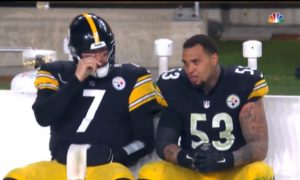Breaking news: quarterbacks performance suffers when they get sacked or hit.
So says the data set presented by Pro Football Focus.
The conclusion seems alarmingly intuitive, but it’s useful to look at some actual statistical analysis to see what reality bears out, rather than relying on conventional thinking.
PFF has published a series of articles over the last few days examining several variables within the data to parse what is actually being communicated, attempting to account for quality of quarterback, game situation, number of hits, depth of pass, etc.
In all, they examined a sample size of 27,273 passes thrown over the past six seasons. They’ve determined that, on average, a quarterback’s accuracy decreases by approximately half a percent with each hit taken.
For this, they use accuracy percentage rather than completion percentage, which neutralizes the effect of dropped passes. Instead, it determines whether or not the quarterback fulfilled his responsibility on the play by getting the ball to a place where it could be caught.
Quarterbacks who have yet to take a hit in a game had an accuracy percentage of around 73. That number dipped to around 70 percent once a quarterback had taken five hits in a game (according to PFF, a quarterback will have taken three hits on average by halftime).
After having taken 10 hits, a quarterback is likely to average less than 68 percent accuracy on throws, a greater than five percent decrease overall.
Additionally, there is a stark upswing in interceptions thrown relative to the number of hits taken. A quarterback with a clean jersey throws an interception just 2.5 percent of the time. After five hits, it climbs to about 3.5 percent, and so forth.
While sample size creates some issues, the data also seems to suggest that the quality of quarterback is not particularly relevant when it comes to protecting against a decline in efficiency after having taken hits.
PFF attempted to isolate the difference between ‘elite’, average, and rookie quarterbacks (limited to first-round picks) over the past six seasons, and, unsurprisingly, all three groupings show a notable decline, with two slight anomalies.
It appears that ‘elite’ quarterbacks are able to prolong a significant drop off in play after the first few hits before their performance suffers. On the other hand, once rookie quarterbacks have accumulated a significant amount of hits, their performance declines steadily.
Likewise, the data also shows that the accuracy relative to depth of target sees a similar decrease in efficiency across the board with the accumulation of hits on the quarterback.
Sample sizes create a bit of chaos with the by-quarter theory, however, especially when it comes to accounting for quarterbacks with zero hits into the second half, because those passes often account for those thrown by backups or injury replacements. After accounting for some of the anomalies, however, the data also appears to argue the case that the more a quarterback is hit, the less accurate he is.
By looking at the data, one might say that the third quarter is the best time for a quarterback to have taken a certain amount of hits. I would speculate that this potentially relates to the obvious factor of halftime, during which a quarterback has time to rest and the offense has time to strategize.
There are more facets of this topic that Pro Football Focus explores in these articles. As mentioned in the beginning of this piece, the findings are all seemingly intuitive, and support the case that quarterback hits negative correlate with quarterback performance.
It would have been interesting to see how Ben Roethlisberger in particular would come out in this data. Nonetheless, I think the data is strong, and if the topic interests you, you might want to look through the articles yourself.
Cumulative Effect: Hitting the QB







